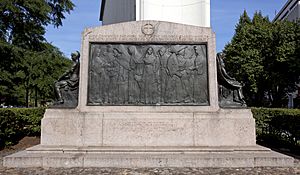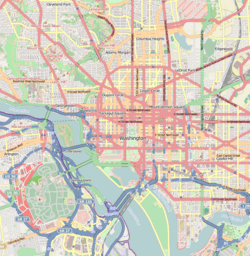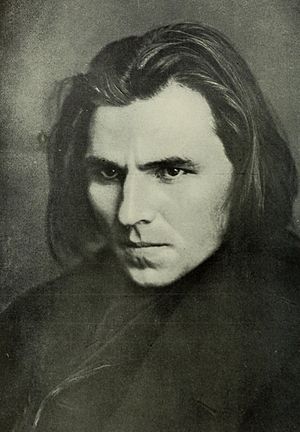Nuns of the Battlefield facts for kids
Quick facts for kids Nuns of the Battlefield |
|
|---|---|
 |
|
| Artist | Jerome Connor |
| Year | 1924 |
| Type | Bronze |
| Dimensions | 182.88 cm × 274.32 cm (72.00 in × 108.00 in) |
| Location | Washington, D.C., United States |
| Owner | National Park Service |
|
Nuns of the Battlefield
|
|
|
U.S. Historic district
Contributing property |
|
| Location | Washington, D.C. |
| Part of | Civil War Monuments in Washington, DC. |
| NRHP reference No. | 78000257 |
| Added to NRHP | September 20, 1978 |
The Nuns of the Battlefield is a special outdoor artwork created in 1924. It was made by an Irish artist named Jerome Connor. You can find it in Washington, D.C., where three streets meet: Rhode Island Avenue NW, M Street, and Connecticut Avenue NW.
This monument honors over 600 nuns. These brave women nursed soldiers from both sides during the American Civil War. It is one of only two monuments in Washington, D.C., that recognize the important roles women played in this war. The monument is part of the Civil War Monuments in Washington, D.C. and is listed on the National Register of Historic Places. In 1993, experts from the Smithsonian Institution checked on it for a program called Save Outdoor Sculpture!.
Contents
What the Monument Looks Like
The main part of the sculpture is a large bronze panel. This panel shows 12 nuns dressed in their traditional religious clothes. This special panel is called a bas relief, which means the figures are carved so they stick out from a flat surface.
The bronze panel is placed on a rectangular granite slab. This slab sits on a granite base. On each end of the slab, there is a seated bronze figure of a woman.
The Figures and Their Meanings
The figure on the right side has wings, a helmet, robes, and armor. She looks like an angel and represents patriotism. She holds a shield in her left hand and a scroll in her lap with her right hand. She does not carry any weapons, which shows she represents peace.
On the left side of the slab, another winged figure sits. She wears a long dress, a bodice, and a scarf on her head. She represents the angel of Peace. Her hands are folded calmly in her lap.
Messages on the Monument
The artist, Jerome Connor, signed his name and the year 1924 on the lower right side of the relief. On the lower left side, you can see the name of the company that made the bronze parts:
- BUREAU BROS.
- BRONZE FOUNDERS PHILA
- ENN
Above the relief, carved into the granite, are these words:
- THEY COMFORTED THE DYING, NURSED THE WOUNDED, CARRIED HOPE TO
- THE IMPRISONED, GAVE IN HIS NAME A DRINK OF WATER TO THE THIRSTY.
Below the relief, also on the granite, is a message explaining who the monument honors:
- TO THE MEMORY AND IN HONOR OF
- THE VARIOUS ORDERS OF SISTERS
- WHO GAVE THEIR SERVICES AS NURSES ON BATTLEFIELDS
- AND IN HOSPITALS DURING THE CIVIL WAR.
On the back of the slab, near the bottom, it says:
- ERECTED BY THE LADIES AUXILIARY TO THE ANCIENT ORDER OF HIBERNIANS OF AMERICA. A.D. 1924
- BY AUTHORITY OF THE CONGRESS OF THE UNITED STATES.
Who Was Jerome Connor?
Jerome Connor was born in Ireland in 1874. When he was 14, his family moved to Massachusetts in the United States. His father was a stonemason, someone who works with stone. This led Connor to jobs in New York as a sign painter, stonecutter, bronze founder, and machinist. Even as a child, Connor loved to carve figures into rocks using his father's tools.
In 1899, he joined the Roycroft Institution. Here, he helped with blacksmithing (working with metal) and started making terracotta busts (sculptures of heads and shoulders) and reliefs. During his four years at Roycroft, he became a well-known sculptor. He was asked to create public artworks in bronze for places like Washington, D.C., Syracuse, East Aurora, New York, San Francisco, and Ireland.
In 1925, he moved back to Ireland and opened his own studio in Dublin. However, he found it hard to get many customers, and his work slowed down. He passed away on August 21, 1943.
How the Monument Came to Be
The idea for the Nuns of the Battlefield monument came from Ellen Jolly. She was the president of the women's group of the Ancient Order of Hibernians. She had grown up hearing stories about the nuns who helped soldiers during the Civil War.
Jolly first suggested the sculpture in the early 1900s. However, the War Department said no because they needed proof that the nuns had served. For ten years, Ellen Jolly worked hard to collect evidence. She finally presented it to Congress in 1918.
Getting Approval and Funding
Congress officially approved the sculpture on March 29, 1918. They agreed to the project, but with one condition: the government would not pay for it. So, a committee led by Ellen Jolly, on behalf of the Ancient Order of the Hibernians, raised $50,000 for the project.
Jerome Connor was chosen as the artist because he often focused on Irish Catholic themes in his art, and he was Irish Catholic himself.
Choosing the Location
There was a delay in building the monument because of where it would be placed. Jerome Connor wanted the sculpture at either Arlington National Cemetery or the Pan American Union Building. However, the War Department and the D.C. Fine Arts Commission did not agree with these choices.
The U.S. Army Corps of Engineers finally chose the current location near Dupont Circle. Once the spot was picked, the Arts Commission asked Connor to make some changes to his design. They wanted him to change the size, move some of the words on the front, rearrange the front steps, and make the angel figures look more "active." A year later, in 1919, Congress finally approved the design. Construction began on July 28, 1924.
The Dedication Ceremony
The monument was officially dedicated on September 20, 1924. This was part of a weekend event that brought over 5,000 Catholics from all over the country to Washington, D.C.
One special guest was Sister Magdeline of the Sisters of Mercy. She had actually served as a nurse in the Civil War! When she attended the event, she received a huge round of applause. Archbishop O'Connell of Boston gave a speech. After his speech, Ellen Jolly revealed the sculpture by removing an American flag that covered it. Sailors then raised signal flags that spelled out "faith, hope and charity," and a group of white pigeons were released into the sky.
Nuns Honored by the Monument
The nuns shown on the relief panel represent many different religious orders. These include:
- Sisters of St. Joseph
- Carmelites
- Dominican Order
- Ursulines
- Sisters of the Holy Cross
- Poor Sisters of St. Francis
- Sisters of Mercy
- Congregation of the Sisters of Our Lady of Mercy
- Daughters of Charity of St. Vincent de Paul
- Sisters of Charity of Nazareth
- Sisters of Providence of Saint Mary-of-the-Woods
- Congregation of Divine Providence




